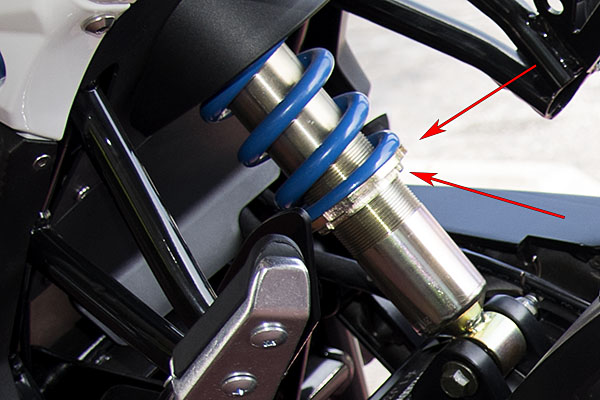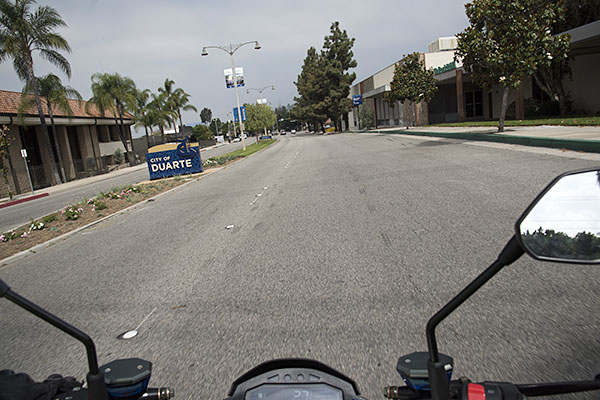
I thought I would add a few words today about the CSC City Slicker’s wheels and suspension.
First, the suspension. Slick’s front end has a conventional non-adjustable inverted front fork with 4.2 inches of travel, and the rear has a swingarm, pre-load-adjustable monoshock, arrangement with 4.3 inches of travel. Here are a couple of photos showing each:


The City Slicker’s suspension felt good to me, and the handling was razor-sharp. On prior internal combustion bikes from Zongshen (the RX3 and the TT250), we realized a handling improvement changing the fork oil from whatever the bikes shipped with to a 10W oil. The City Slicker did not feel to me like it needed this change. The front suspension feels good right out of the box. The was no bottoming out, nor was there any topping out (when the forks fully extend). The rear suspension felt firmer to me than it needed to be, but I noticed the rear shock had been set with the spring preload adjustment in the middle of the monoshock’s adjustment range. There appears to be plenty of room for adjustment. This can be accomplished by using a spanner to unlock the locknuts and relax the spring a bit (this assumes the spring is already compressed a bit with the adjustment as delivered by the factory). I haven’t tried this yet, but I will the next time I have an opportunity to do so.

The wheels on the City Slicker are 12 inches in diameter, which is the same as most scooters, the Honda Grom, the CSC Mustang replicas, and the original Mustang motorcycles. On one of the many recent forums discussing the new City Slicker, a poster commented that 12-inch wheels are dangerous…you know, you might hit a pothole in the rain and get thrown from the bike. I don’t think that should be a concern. The truth is this: 12-inch wheels are a common design on smaller bikes and they make for incredibly quick handling. When I was on my 150cc CSC Mustang replica, I rediscovered what Walt Fulton proved back in the 1950s (more on that in a second). My CSC 150 had 12-inch wheels (just like the original Mustangs) and it was awesome in the twisties.

Glendora Ridge Road, up in the San Gabriel Mountains, is just few miles from my house. It’s a great road from many perspectives, not the least of which is a set of glorious twisties. It is my favorite ride, and I wrote a story about it for Motorcycle Classics magazine. The point that I’m getting to in my very roundabout way is this: When I was on Glendora Ridge Road on my 150cc Mustang, I could hang with any bike up there, and most other motorcycles of any displacement couldn’t catch me (other than on GRR’s very few short straights). In the corners, my little 150 was king. It was all about wheel diameter and handling. You might not believe me, but there are more than a few riders I’ve met up there who know. They’re not talking about it, but they know. They’ve been humbled.

So, back to Walt Fulton. He was a famous factory racer back in the 1950s who had lost his factory ride with another manufacturer. This was just before the Catalina Grand Prix, and Fulton did not have a ride. At the last minute, the Mustang Motor Corporation offered Fulton a factory spot, he accepted, and he nearly won on his 320cc, 12-inch-wheeled Mustang. Fulton passed 145 other riders on machines with up to four times the displacement (and, of course, larger wheels).
Fulton’s engine failed just a few miles from the finish, but he was on a tack to win that event. To make a long story just a little less long, the other factories complained to the Catalina Grand Prix organizers and delivered an ultimatum: Find a way to outlaw that damned Mustang next year, or we’re picking up our marbles and going home. Whaddya know…there was a sudden change to the rules. As Forrest Gump might say, just like that no one could race with wheels smaller than 16 inches. Yup. It happens.
The bottom line here is this: Slick’s 12-inch wheels make for extremely crisp handling. If you’ve never ridden a bike with 12-inch wheels, you really need to try one. I’ve found the handling is sharper than anything I’ve ever experienced.
